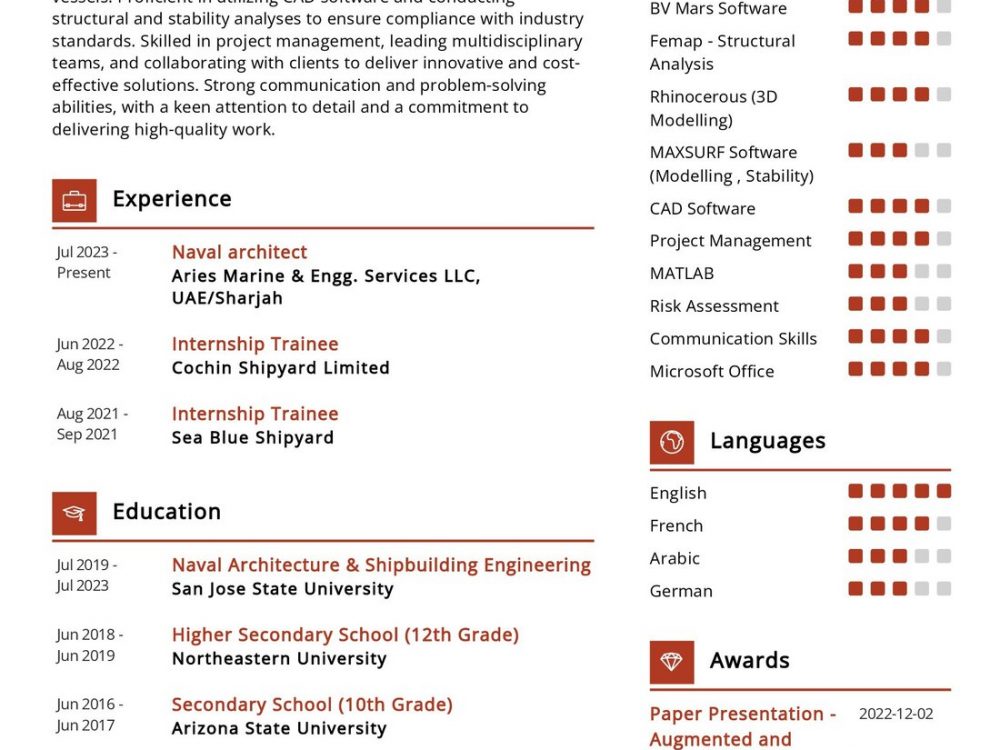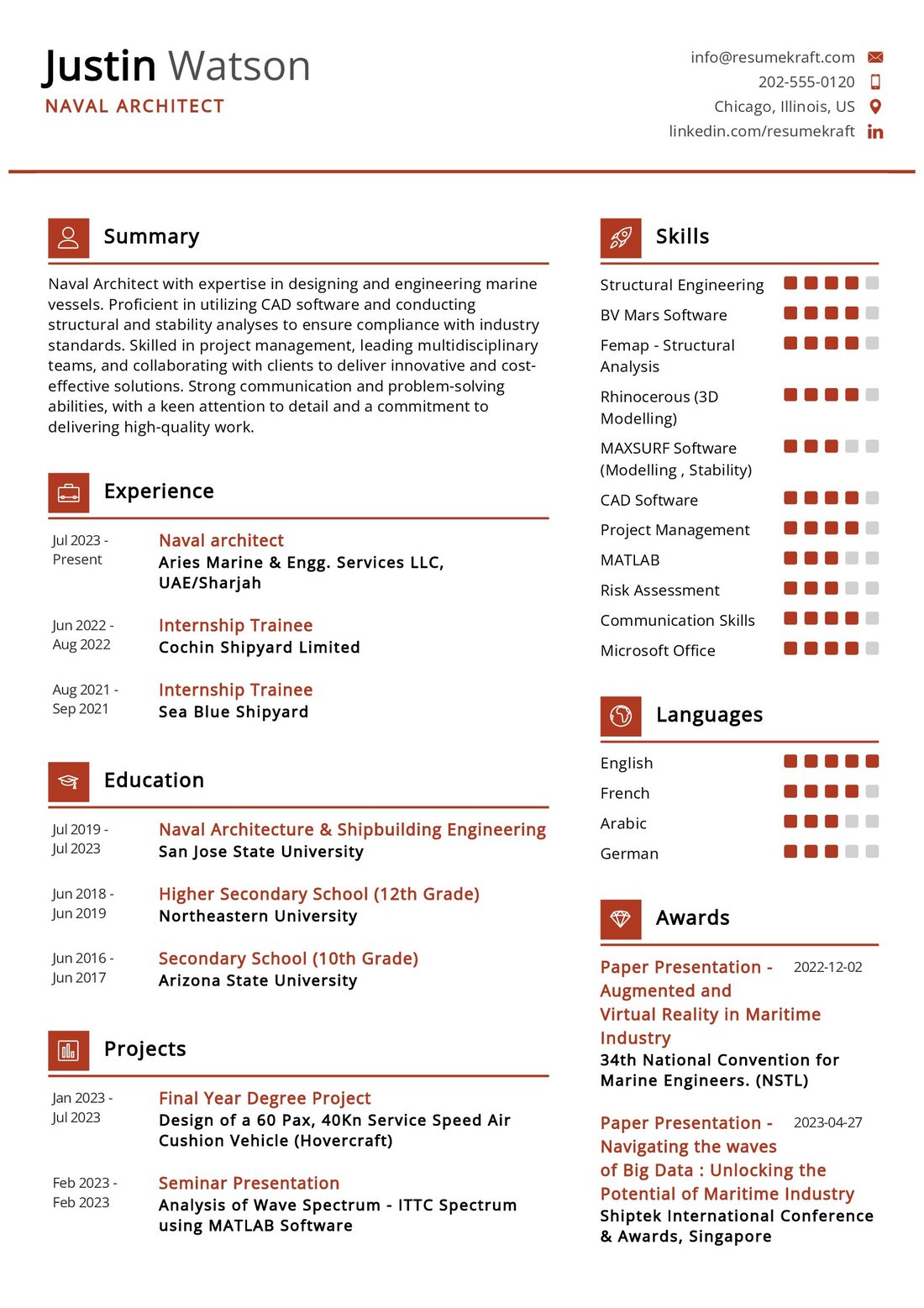What is the Role of a Naval Architect?
As the maritime industry continues to evolve, the role of a Naval Architect has become increasingly pivotal in ship design, construction, and maintenance. This position combines technical expertise with innovative thinking, guiding the creation of vessels that sail the world’s waters. Let’s dive deeper into the multifaceted role of a Naval Architect, a profession that demands a deep understanding of naval engineering, creative problem-solving, and effective collaboration.
A Naval Architect is responsible for overseeing the design, construction, and maintenance of various types of waterborne vessels, from ships and boats to offshore structures. They play a crucial role in ensuring that these vessels are not only seaworthy but also efficient, environmentally friendly, and compliant with safety regulations. Their work bridges the gap between the technical aspects of ship design and the practical requirements of the maritime industry, making them key players in this dynamic field.
What are the Naval Architect Job Requirements?
Becoming a Naval Architect involves meeting several stringent requirements, a journey that is both demanding and rewarding. The path to this profession is paved with continuous learning, gaining hands-on experience, and developing a unique skill set. Let’s delve into the prerequisites needed to embrace the role of a Naval Architect:
- A Bachelor’s or Master’s degree in Naval Architecture, Marine Engineering, or a related field, showcasing a strong foundation in naval engineering principles.
- Profound knowledge of ship design and construction, including structural integrity, hydrodynamics, stability, and safety regulations.
- Experience in naval architecture projects, demonstrating the ability to apply theoretical knowledge to real-world scenarios.
- Strong problem-solving and analytical skills, honed through academic coursework and practical experiences.
- Proficiency in computer-aided design (CAD) software and other relevant tools used in ship design and analysis.
- Excellent communication skills to collaborate with interdisciplinary teams, clients, and regulatory bodies.
- Adaptability to work in a dynamic industry with evolving technologies and changing design requirements.
Obtaining additional certifications or specialized training in areas like ship safety, environmental regulations, or offshore engineering can enhance your profile in the competitive maritime job market.
What are the Responsibilities of a Naval Architect?
The role of a Naval Architect is a diverse set of responsibilities, each contributing to the creation of safe, efficient, and innovative waterborne vessels. Let’s explore the core responsibilities that define this profession, highlighting the vital role they play in shaping the maritime industry:
- Designing vessels that meet specific client requirements, considering factors such as size, capacity, intended use, and budget constraints.
- Performing hydrostatic and hydrodynamic calculations to ensure a ship’s stability, buoyancy, and performance in different sea conditions.
- Collaborating with marine engineers, structural engineers, and shipbuilders to create detailed construction plans and specifications.
- Conducting feasibility studies and risk assessments to evaluate the technical and financial viability of shipbuilding projects.
- Ensuring that vessel designs comply with international maritime regulations and safety standards, addressing issues related to seaworthiness and environmental impact.
- Overseeing the construction phase, conducting inspections, and making design modifications as needed to ensure quality and safety.
- Advising clients on vessel modification or retrofitting projects to enhance performance, reduce emissions, or extend the lifespan of existing vessels.
- Keeping abreast of advancements in ship design technology, materials, and sustainability practices to incorporate innovative solutions into projects.
Each responsibility is a vital thread in the fabric of naval architecture, contributing to the safe and efficient movement of goods and people across the world’s oceans.
Naval Architect Resume Writing Tips
When crafting your resume as a Naval Architect, it’s essential to present your qualifications and experiences effectively to stand out in the competitive job market. Here are some tips to help you create a compelling resume:
- Highlight your specific areas of expertise within naval architecture, such as ship design, stability analysis, or marine safety.
- Showcase successful projects you’ve worked on, emphasizing the impact of your contributions on the vessels’ performance, safety, or efficiency.
- Include quantitative achievements, such as percentage improvements in vessel stability or cost savings through innovative design solutions.
- List any relevant certifications or training programs you’ve completed, particularly those related to ship safety, environmental regulations, or advanced CAD software.
- Customize your resume for each job application by tailoring your qualifications and experiences to match the specific requirements of the position.
Your resume is a tool to communicate your expertise and potential value as a Naval Architect to prospective employers. Make it clear, concise, and tailored to the job you’re applying for.
Naval Architect Resume Summary Examples
Your resume summary serves as an introduction to your qualifications and sets the tone for the rest of your resume. Here are some examples of compelling Naval Architect resume summaries:
- “Experienced Naval Architect with a passion for innovative ship design and a track record of creating vessels that excel in both performance and safety. Skilled in using advanced CAD software to turn concepts into practical designs.”
- “Results-driven Naval Architect with a strong foundation in hydrodynamics and stability analysis. Known for collaborating effectively with cross-functional teams to deliver shipbuilding projects that meet or exceed client expectations.”
- “Naval Architect specializing in environmental sustainability and maritime safety. Adept at integrating eco-friendly technologies into vessel design while ensuring compliance with international regulations.”
Your resume summary should provide a glimpse of your expertise, your approach to naval architecture, and your commitment to excellence.
Create a Strong Experience Section for Your Naval Architect Resume
Your experience section is the core of your resume, where you detail your career achievements and contributions. Here are some examples of how to effectively describe your experience as a Naval Architect:
- “Led the design team for a 200-foot luxury yacht, overseeing all aspects of the project from initial concept to final construction. Achieved a 15% improvement in fuel efficiency through hull design optimizations.”
- “Contributed to the development of a groundbreaking offshore wind turbine installation vessel, incorporating advanced stability and dynamic positioning systems. Ensured compliance with stringent safety standards, resulting in incident-free operations.”
- “Managed the retrofitting of an aging cargo ship to reduce emissions and improve fuel efficiency. Implemented innovative propulsion and energy-saving systems, resulting in a 20% reduction in fuel consumption.”
Each experience should highlight your leadership, problem-solving abilities, and the tangible impact you’ve had on ship design and performance.
Sample Education Section for Your Naval Architect Resume
Your educational background is essential in establishing your expertise as a Naval Architect. Here’s how you can present your educational milestones:
- Master of Science in Naval Architecture, XYZ University, a comprehensive program covering advanced ship design principles and analysis techniques, 2018.
- Bachelor of Science in Marine Engineering, ABC University, a solid foundation in marine systems and engineering principles, 2014.
- Certified Marine Safety Professional (CMSP), a recognition of expertise in maritime safety practices and regulations, 2019.
Your education showcases your commitment to the field and your readiness to tackle complex naval architecture challenges.
Naval Architect Skills for Your Resume
Your skill set is your toolkit, equipped with a diverse range of tools that you have honed over the years. It is a showcase of your abilities, both innate and acquired. Let’s list down the essential skills that a Naval Architect should possess:
Technical Skills:
- Ship design and analysis, the ability to create vessel plans that optimize performance and safety.
- Hydrodynamics and stability analysis, an understanding of how ships behave in various sea conditions.
- Computer-aided design (CAD) software proficiency, the use of digital tools to create detailed ship blueprints.
- Knowledge of international maritime regulations, ensuring that vessel designs comply with safety and environmental standards.
- Project management, the ability to oversee shipbuilding projects from concept to completion.
- Environmental sustainability, the integration of eco-friendly technologies and practices into ship design.
Soft Skills:
- Problem-solving and critical thinking, the ability to address complex design challenges and safety concerns.
- Communication and collaboration, effective interaction with interdisciplinary teams and clients.
- Attention to detail, ensuring accuracy in ship plans and compliance with regulations.
- Adaptability and creativity, the capacity to innovate in ship design and embrace new technologies.
- Analytical skills, the capability to analyze data and make informed design decisions.
Each skill is a tool, aiding you in creating vessels that navigate the seas efficiently and safely.
Common Mistakes to Avoid When Writing a Naval Architect Resume
When crafting your Naval Architect resume, avoid common pitfalls that can hinder your chances of landing your dream job. Here are some mistakes to steer clear of:
- Using a generic resume for all applications, rather than tailoring it to the specific job requirements.
- Focusing solely on job duties without highlighting your achievements and the impact of your work.
- Neglecting the importance of a well-crafted cover letter, a valuable tool to express your enthusiasm and qualifications.
- Overloading your resume with technical jargon that may not be understood by non-technical readers.
- Forgetting to proofread your resume for errors, which can undermine your professional image.
Each mistake can be a stumbling block on your path to securing your ideal position as a Naval Architect. Avoid them to craft a resume that effectively communicates your qualifications and potential.
Key Takeaways for Your Naval Architect Resume
As we reach the end of this comprehensive guide, let’s recap the key points to keep in mind while crafting your Naval Architect resume:
- Showcase your expertise in specific areas of naval architecture that align with the job requirements.
- Highlight your contributions to ship design, emphasizing achievements and improvements in vessel performance, safety, or efficiency.
- Include quantitative data and certifications to bolster your qualifications.
- Customize your resume for each job application to align with the specific needs of the employer.
Finally, feel free to utilize resources like AI Resume Builder, Resume Design, Resume Samples, Resume Examples, Resume Skills, Resume Help, Resume Synonyms, and Job Responsibilities to create a standout application and prepare for the Naval Architect job interview.
With these insights and tips, you are now well-equipped to craft a resume that effectively communicates your skills, experiences, and passion for naval architecture. Remember, your resume is not just a document; it is a reflection of your journey, your expertise, and your commitment to shaping the maritime industry.


